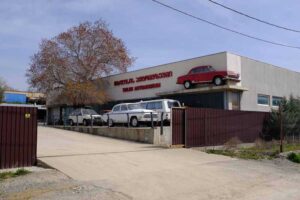
Ural Ataman Classic Car Museum – Istanbul, Turkey
This has to be one of the nicest private collections I have seen, the Ural Ataman Museum in Istanbul, turkey has not only a wide

The seat belt, or safety belt if you prefer, has probably saved more lives than any other invention. These days it’s taken for granted, but five decades ago this wasn’t the case. But since then, it has been unilaterally adopted, and its thanks in some part to Volkswagen with the ESVW 1.
Back in the 1960s in America some 60,000 people were dying each year in car crashes. The U.S Department of Transport introduced an experimental safety vehicle project and asked carmakers and other companies to develop vehicles with safety in mind.
The intention wasn’t to develop working vehicle and some of them barely moved and weighted 6,000 lbs. It was to innovate new ideas for protecting passengers and to develop solutions that could save lives. These prototypes enabled the DOT to establish many passive safety targets for future regulations.
Back in 1955 Volkswagen were working on advanced body frames and launched its first crash tests in 1965. In the 1970s it began working on an experimental safety vehicle using the DOT rules called the ESVW 1.
The car was specifically designed to protect occupants from fatal injuries. The prototype has anti-lock brakes and advanced side protection. Volkswagen built the frame in three sections which were designed to transmit energy away from those inside. The first passive safety belt systems, which included on for over the shoulders, over the knees and midsections.
Even though many cars had seat belts in the 1970s not many people were using them. The passive system in the ESVW 1 was activated by the driver opening the door and getting into the front seat. The horizontal strap would automatically wrap around the driver and in the event of a crash all three belts would tighten automatically.
Even the wipers were designed to provide maximum visibility, and a second set were used on the headlights.

This has to be one of the nicest private collections I have seen, the Ural Ataman Museum in Istanbul, turkey has not only a wide

You may not have heard of this, but the small car museum in Tbilisi Georgia really has quite a lot to see. Buried in an

Bahrain Bike Week is the biggest event of its kind in the Middle East and the 2024 one was no exception. It’s not just the

Ford have granted a licence to Boreham Motorworks, a division of the DVRN Automotive Group, to produce new versions of not just the Mk1 Escort

Europe’s number 1 selling car the VW Golf has reached 50 years old this year, starting production on the 29th of March 1974. In

Ford’s expansion through the early 20th century was something to behold, the rapid growth of the company and the success of the Model T led
There were many unusual things about the ESVW 1. Only the seat cushions moved and only up and down. To adjust the reach to the controls the steering wheel as part of the cockpit would slide towards or away from the driver. The pedals also moved in a similar way.
The power came in the form of a flat four 100 hp engine mounted in the rear, of course. The front provided trunk storage but there was additional capacity above the engine in the rear.
The debut in 1972 took place at global automotive safety conference. Volkswagen presented the car and the testing results. 14 crash test trial with the ESVW 1 passenger cell, handling and swerve tests and a further 40 crash tests with production vehicles.
The ESVW 1 met all of the U.S safety standards and paved the way forward for many of the innovations to make it to production vehicles. Passive safety belts would be used in the Rabbit (Golf) and the crash safety was built into all following Volkswagen today.